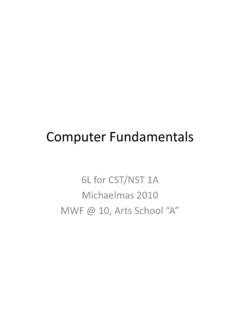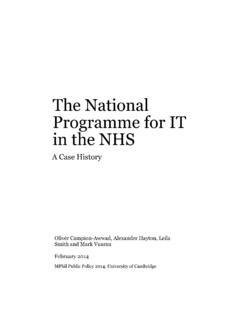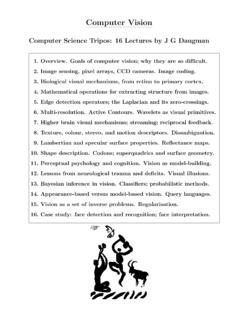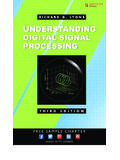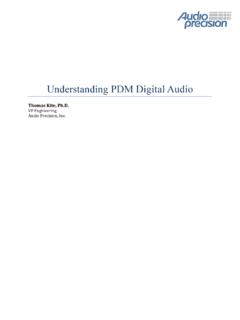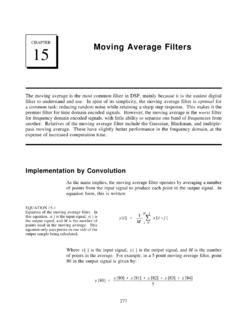Transcription of Digital Signal Processing - University of Cambridge
1 Digital Signal ProcessingMarkus KuhnComputer 2009 Part IISignals flow of information measured quantity that varies with time (or position) electrical Signal received from a transducer(microphone, thermometer, accelerometer, antenna, etc.) electrical Signal that controls a processContinuous-time signals:voltage, current, temperature, speed, ..Discrete-time signals:daily minimum/maximum temperature,lap intervals in races, sampled continuous signals, ..Electronics (unlike optics) can only deal easily with time-dependent signals, therefore spatialsignals, such as images, are typically first converted into a time Signal with ascanning process(TV, fax, etc.)
2 2 Signal processingSignals may have to be transformed in order to amplify or filter out embedded information detect patterns prepare the Signal to survive a transmission channel prevent interference with other signals sharing a medium undo distortions contributed by a transmission channel compensate for sensor deficiencies find information encoded in a different domainTo do so, we also need methods to measure, characterise, model and simulate trans-mission channels mathematical tools that split common channels and transfor-mations into easily manipulated building blocks3 Analog electronicsPassive networks (resistors, capacitors,inductances, crystals, SAW filters),non-linear elements (diodes.)
3 ,(roughly) linear operational amplifiersAdvantages: passive networks are highly linearover a very large dynamic rangeand large bandwidths analog Signal - Processing circuitsrequire little or no power analog circuits cause little addi-tional interferenceRUinUoutCL0 (= 2 f)Uout1/ LCUin UinUouttUin UoutR=1 LZt Uoutd +CdUoutdt4 Digital Signal processingAnalog/ Digital and Digital /analog converter, CPU, DSP, ASIC, : noise is easy to control after initial quantization highly linear (within limited dynamic range) complex algorithms fit into a single chip flexibility, parameters can easily be varied in software Digital Processing is insensitive to component tolerances, aging,environmental conditions, electromagnetic interferenceBut.
4 Discrete-time Processing artifacts (aliasing) can require significantly more power (battery, cooling) Digital clock and switching cause interference5 Typical DSP applications communication systemsmodulation/demodulation, channelequalization, echo cancellation consumer electronicsperceptual coding of audio and videoon DVDs, speech synthesis, speechrecognition musicsynthetic instruments, audio effects,noise reduction medical diagnosticsmagnetic-resonance and ultrasonicimaging, computer tomography,ECG, EEG, MEG, AED, audiology geophysicsseismology, oil exploration astronomyVLBI, speckle interferometry experimental physicssensor-data evaluation aviationradar, radio navigation securitysteganography, Digital watermarking,biometric identification.
5 Surveillancesystems, signals intelligence, elec-tronic warfare engineeringcontrol systems, feature extractionfor pattern recognition6 SyllabusSignals and sequences and systems, their types and proper-ties. Linear time-invariant systems, convolution. Harmonic phasors are the eigenfunctions of linear time-invariant systems. Review of complex arithmetic. Someexamples from electronics, optics and of MATLAB on PWF machines to perform numerical experimentsand visualise the results in homework phasors as orthogonal base functions. Forms of theFourier transform, convolution theorem, Dirac s delta function, impulse combs inthe time and frequency sequences and sampling of continuous signals, pe-riodic signals, aliasing, sampling and reconstruction of low-pass and band-passsignals, spectral Fourier Fourier transform, sym-metry, linearity, review of the FFT, real-valued and scalloping phenomena, windowing, zero and infinite impulse-response of filters, implementa-tion forms, window-based FIR design, use of frequency-inversion to obtain high-pass filters, use of modulation to obtain band-pass filters, FFT-basedconvolution,polynomial representation,z-transform.
6 Zeros and poles, use of analog IIR designtechniques (Butterworth, Chebyshev I/II, elliptic filters).Random sequences and variables, stationary processes, autocor-relation, crosscorrelation, deterministic crosscorrelation sequences, filtered randomsequences, white noise, exponential vectors, dependence versus correlation, covariance,decorrelation, matrix diagonalisation, eigen decomposition, Karhunen-Lo`eve trans-form, principal/independent component analysis. Relation to orthogonal transformcoding using fixed basis vectors, such as versus lossless information is discarded by humansenses and can be eliminated by encoders? Perceptual scales, masking, spatialresolution, colour coordinates, some demonstration , image and audio coding -law coding, delta cod-ing, JPEG photographic still-image compression, motion compensation, MPEG video encoding, MPEG audio : The last three lectures on audio-visual coding were previously part of the course Informa-tion Theory and Coding.
7 A brief introduction to MATLAB was given in Unix Tools .8 ObjectivesBy the end of the course, you should be able to apply basic properties of time-invariant linear systems understand sampling, aliasing, convolution, filtering, the pitfalls ofspectral estimation explain the above in time and frequency domain representations use filter-design software visualise and discuss Digital filters in thez-domain use the FFT for convolution, deconvolution, filtering implement, apply and evaluate simple DSP applications in MATLAB apply transforms that reduce correlation between several Signal sources understand and explain limits in human perception that are ex-ploited by lossy compression techniques provide a good overview of the principles and characteristicsof sev-eral widely-used compression techniques and standards for audio-visual signals9 Textbooks Lyons: understanding Digital Signal , 2004.
8 ( 45) Oppenheim, Schafer:Discrete-time Signal ed., Prentice-Hall, 1999. ( 47) J. Stein: Digital Signal Processing a computer science , 2000. ( 74) Smith: Digital Signal Processing a practical guide forengineers and , 2003. ( 40) K. Steiglitz:A Digital Signal Processing primer with appli-cations to Digital audio and computer ,1996. ( 40) Sanjit K. Mitra: Digital Signal Processing a , 2002. ( 38)10 Sequences and systemsAdiscrete sequence{xn} n= is a sequence of ,x 2,x 1,x0,x1,x2,..wherexndenotes then-th number in the sequence (n Z). A discretesequence maps integer numbers onto real (or complex) normally abbreviate{xn} n= to{xn}, or to{xn}nif the running index is not notation is not well standardized.
9 Some authors writex[n] instead ofxn, othersx(n).Where a discrete sequence{xn}samples a continuous functionx(t) asxn=x(ts n) =x(n/fs),we calltsthesampling periodandfs= 1/tsthesampling systemTreceives as input a sequence{xn}and transformsit into an output sequence{yn}=T{xn}:.. , x2, x1, x0, x 1, .. , y2, y1, y0, y 1, ..discretesystemT11 Properties of sequencesA sequence{xn}isabsolutely summable Xn= |xn|< square summable Xn= |xn|2< periodic k >0 : n Z:xn=xn+kA square-summable sequence is also called anenergy Signal , and Xn= |xn|2is its energy. This terminology reflects that ifUis a voltage supplied to a loadresistorR, thenP=U I=U2/Ris the power consumed, andRP(t) dtthe even where we drop physical units ( , volts) for simplicity in calculations, itis still customary to refer to the squared values of a sequence aspowerand to itssum or integral over time non-square-summable sequence is apower signalif its average powerlimk 11 + 2kkXn= k|xn| sequencesUnit-step sequence:un= 0, n <01, n 0 Impulse sequence: n= 1, n= 00, n6= 0=un un 113 Types of discrete systemsAcausal systemcannot look into the future:yn=f(xn,xn 1,xn 2.)
10 Amemory-less systemdepends only on the current input value:yn=f(xn)Adelay systemshifts a sequence in time:yn=xn dTis atime-invariant systemif for anyd{yn}=T{xn} {yn d}=T{xn d}.Tis alinear systemif for any pair of sequences{xn}and{x n}T{a xn+b x n}=a T{xn}+b T{x n}.14 Examples:Theaccumulator systemyn=nXk= xkis a causal, linear, time-invariant system with memory, as are theback-ward difference systemyn=xn xn 1,theM-point moving average systemyn=1MM 1Xk=0xn k=xn M+1+ +xn 1+xnMand theexponential averaging systemyn= xn+ (1 ) yn 1= Xk=0(1 )k xn for time-invariant non-linear memory-less systems:yn=x2n, yn= log2xn, yn= max{min{ 256xn ,255},0}Examples for linear but not time-invariant systems:yn= xn, n 00, n <0=xn unyn=x n/4 yn=xn (e jn)Examples for linear time-invariant non-causal systems.

